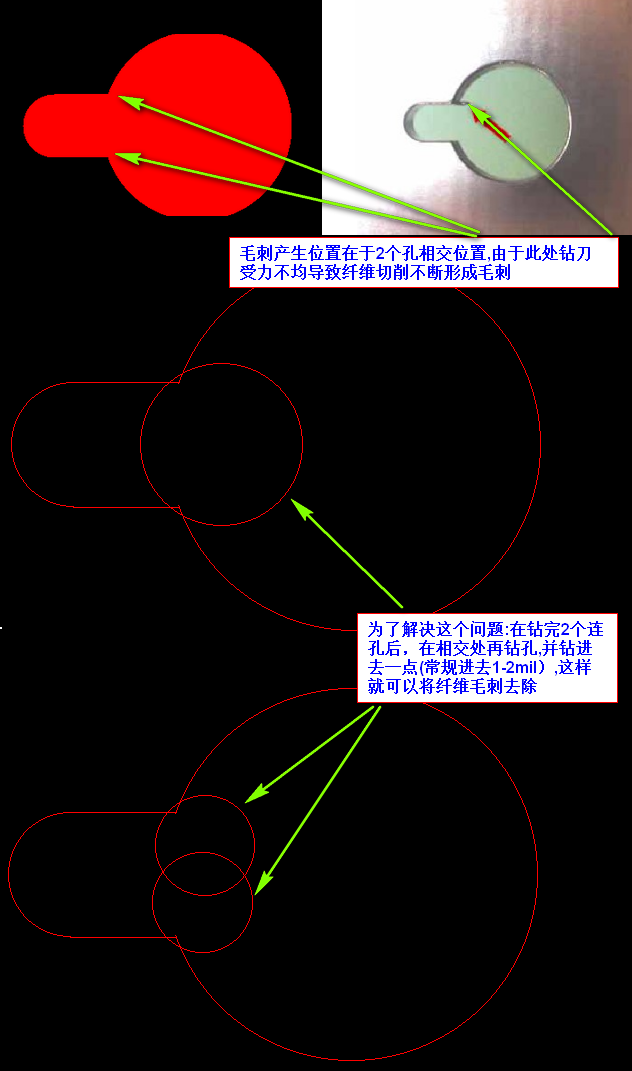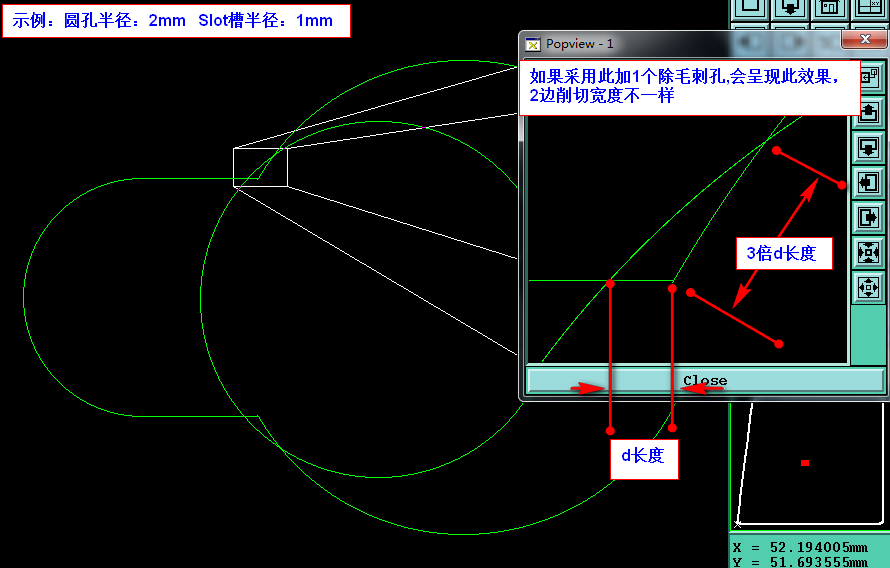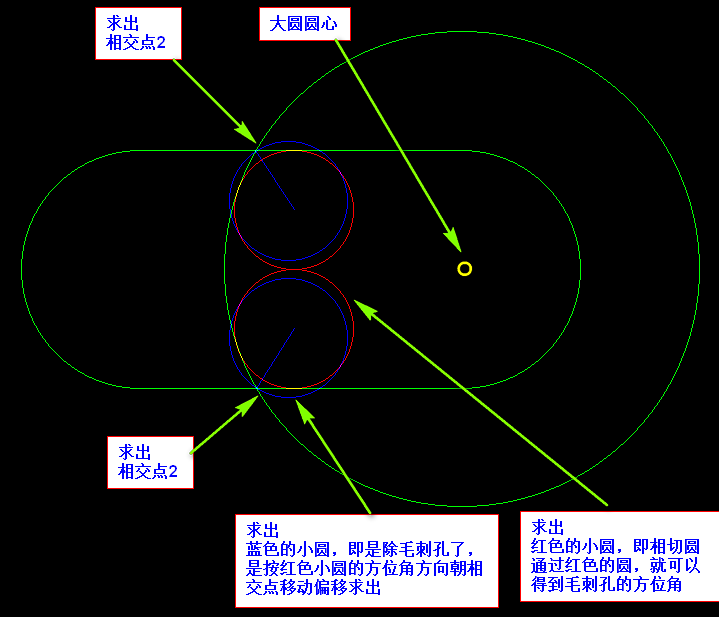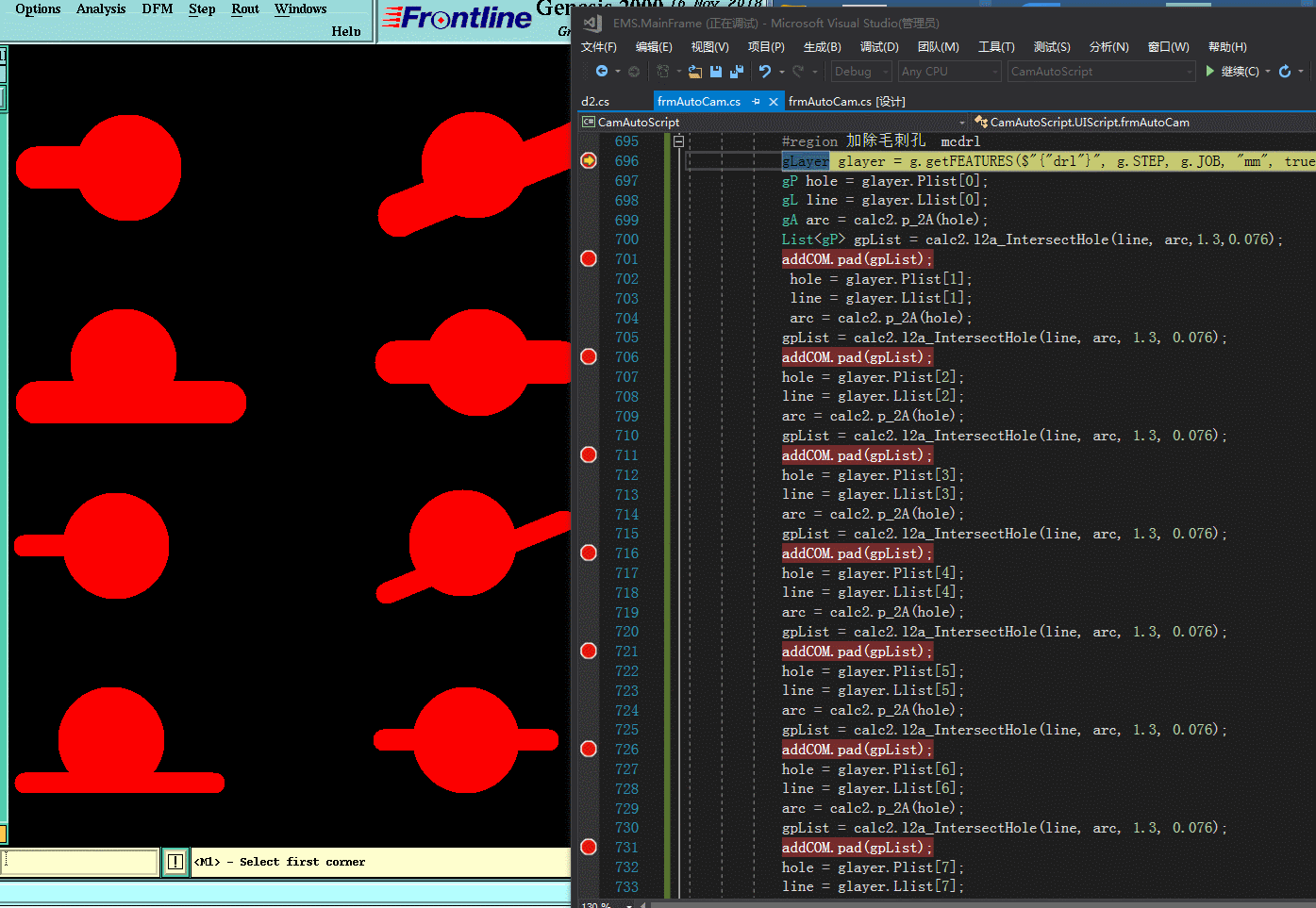PCB genesis连孔加除毛刺孔(圆孔与槽孔)实现方法(二)
一.为什么 连孔加除毛刺孔
原因是 PCB板材中含有玻璃纤维, 毛刺产生位置在于2个孔相交位置,由于此处钻刀受力不均导致纤维切削不断形成毛刺 ,为了解决这个问题:在钻完2个连孔后,在相交处再钻一个孔,并钻进去一点(常规进去1-2mil),这样就可以将纤维毛刺去除

PCB同行业毛刺问题处理办法 钻孔孔内毛刺问题分析改善报告
二.如何判断除毛刺孔是加1个还是2个呢?
在PCB行业工程加除毛刺孔是加1个孔还是2个孔,没有太明确的定义,只要满足毛刺去除即可.
我们先看下面这个示例(采用此加1个除毛刺孔,会呈现此效果,2边削切宽度不一样)为了防止此切削宽度不一致现象,所以需采用增加2个除毛刺孔。
这边测试后得出一个判断条件(但不一定适合所有工厂),加1个除毛刺孔条件需满足: (1.槽半径小于三分之二大圆半径时,增加1个毛刺孔 2.槽宽>=0.8mm,增加1个毛刺孔),否则需加2个毛刺孔

三.连孔加除毛刺孔实现原理
除毛刺孔,这里列举几个关键参数,如下图所示(因为求解的参数太多,画图不好呈现,具体请看下方的代码)
1.加1 个孔

2.加2个孔

四.C#简易代码实现:
1.加除毛刺孔代码
- #region 加除毛刺孔 mcdrl
- gLayer glayer = g.getFEATURES($"{"drl"}", g.STEP, g.JOB, "mm", true);
- gP hole = glayer.Plist[];
- gL line = glayer.Llist[];
- gA arc = calc2.p_2A(hole);
- List<gP> gpList = calc2.l2a_IntersectHole(line, arc,1.3,0.076);
- addCOM.pad(gpList);
- #endregion
2.计算函数
- /// <summary>
- /// 求线段与弧2个交点
- /// </summary>
- /// <param name="L1"></param>
- /// <param name="L2"></param>
- /// <param name="HoleScale">当加1个孔时 是开口宽度1.3倍</param>
- /// <param name="CutInner">切入板内0.05mm</param>
- /// <returns></returns>
- public List<gP> l2a_IntersectHole(gL l, gA a, double HoleScale = 1.3, double CutInner = 0.05)
- {
- List<gP> gpList = new List<gP>();
- double Lwidth = l.width * 0.001;
- gL lineL, lineR;
- l_offset(l, Lwidth * 0.5, out lineL, out lineR);
- gPoint gpL = new gPoint();
- gPoint gpR = new gPoint();
- int isIntersectL = , isIntersectR = ;
- double A_Radius = p2p_di(a.pc, a.ps);
- gL l1 = l2a_Intersect(lineL, a, ref gpL, ref isIntersectL);
- gL l2 = l2a_Intersect(lineR, a, ref gpR, ref isIntersectR);
- gL gpL1 = new gL(l1.ps, l2.ps, );
- double gpL1di = l_Length(gpL1);
- gL gpL2 = new gL(l1.pe, l2.pe, );
- double gpL2di = l_Length(gpL2);
- if (isIntersectL + isIntersectR < )
- gpL1di = ;
- //钻1个孔条件
- if (gpL1di < A_Radius * 0.667 && gpL1di >= 0.8) //当小于Slot槽宽要小于0.667倍大圆半径,且Slot槽需大于0.8
- {
- if (p2p_di(lineL.ps, a.pc) >= A_Radius && p2p_di(lineR.ps, a.pc) >= A_Radius)
- {
- double Hole_Radius = ((int)(Math.Ceiling(((gpL1di + CutInner) * HoleScale * ) / )) * ) * 0.0005;
- gP gpL1P = l2a_CentereExtend(gpL1, a, Hole_Radius - CutInner);
- gpList.Add(new gP(gpL1P.p, (Hole_Radius) * ));
- }
- if (p2p_di(lineL.pe, a.pc) >= A_Radius && p2p_di(lineR.pe, a.pc) >= A_Radius)
- {
- double Hole_Radius = ((int)(Math.Ceiling(((gpL2di + CutInner) * HoleScale * ) / )) * ) * 0.0005;
- gP gpL2P = l2a_CentereExtend(gpL2, a, Hole_Radius - CutInner);
- gpList.Add(new gP(gpL2P.p, (Hole_Radius) * ));
- }
- }
- else //钻2个孔
- {
- double Radius = (isIntersectL + isIntersectR < ) ? Lwidth * 0.5 : gpL1di * 0.5;
- double multiLval = multi(lineL.ps, lineL.pe, a.pc);
- double multiRval = multi(lineR.ps, lineR.pe, a.pc);
- bool isSameSide = (multiLval >= && multiRval >= ) || (multiLval <= && multiRval <= );
- int line1L_Position = , line1R_Position = ; ;
- if (isSameSide)
- {
- if (Math.Abs(multiLval) > Math.Abs(multiRval))
- line1R_Position = ;
- else
- line1L_Position = ;
- }
- if (isIntersectL == )
- {
- gL_di line1L = l2a__Round(lineL, a, 0.05, 0.5, , line1L_Position);
- if (line1L.isIntersect)
- {
- gPoint pointLP1 = p_val_ang(line1L.pc, Radius - CutInner, line1L.ang_direction);
- gpList.Add(new gP(pointLP1, Radius * ));
- }
- gL_di line1R = l2a__Round(lineL, a, 0.05, 0.5, , line1L_Position);
- if (line1R.isIntersect)
- {
- gPoint pointLP2 = p_val_ang(line1R.pc, Radius - CutInner, line1R.ang_direction);
- gpList.Add(new gP(pointLP2, Radius * ));
- }
- }
- if (isIntersectR == )
- {
- gL_di line2L = l2a__Round(lineR, a, 0.05, 0.5, , line1R_Position);
- if (line2L.isIntersect)
- {
- gPoint pointRP3 = p_val_ang(line2L.pc, Radius - CutInner, line2L.ang_direction);
- gpList.Add(new gP(pointRP3, Radius * ));
- }
- gL_di line2R = l2a__Round(lineR, a, 0.05, 0.5, , line1R_Position);
- if (line2R.isIntersect)
- {
- gPoint pointRP4 = p_val_ang(line2R.pc, Radius - CutInner, line2R.ang_direction);
- gpList.Add(new gP(pointRP4, Radius * ));
- }
- }
- }
- return gpList;
- }
- /// <summary>
- /// 线Line偏移 out 左与右偏移线Line
- /// </summary>
- /// <param name="l"></param>
- /// <param name="offset_val">偏移数值</param>
- /// <param name="left_l">out 左偏移线L</param>
- /// <param name="rithg_l">out 右偏移线L</param>
- public void l_offset(gL l, double offset_val, out gL left_l, out gL rithg_l)
- {
- left_l = l;
- rithg_l = l;
- double angle_ = p_ang(l.ps, l.pe);
- left_l.ps = p_val_ang(l.ps, offset_val, angle_ + );
- left_l.pe = p_val_ang(l.pe, offset_val, angle_ + );
- rithg_l.ps = p_val_ang(l.ps, offset_val, angle_ - );
- rithg_l.pe = p_val_ang(l.pe, offset_val, angle_ - );
- }
- /// <summary>
- /// 返回两点之间欧氏距离
- /// </summary>
- /// <param name="p1"></param>
- /// <param name="p2"></param>
- /// <returns></returns>
- public double p2p_di(gPoint p1, gPoint p2)
- {
- return Math.Sqrt((p1.x - p2.x) * (p1.x - p2.x) + (p1.y - p2.y) * (p1.y - p2.y));
- }
- /// <summary>
- /// 求线段与弧2个交点
- /// </summary>
- /// <param name="l"></param>
- /// <param name="a"></param>
- /// <param name="gp">垂足</param>
- /// <param name="isIntersectType">1本身相交 0本身不相交 (相对于圆而言)</param>
- /// <returns></returns>
- public gL l2a_Intersect(gL l, gA a, ref gPoint gp, ref int isIntersectType)
- {
- gp = p2l_toP(a.pc, l);
- double pc2gpDi = p2p_di(gp, a.pc);
- double Radius = p2p_di(a.pc, a.ps);
- isIntersectType = Radius >= pc2gpDi ? : ;
- double val = Math.Sqrt(Math.Pow(Radius, ) - Math.Pow(pc2gpDi, ));
- double ang = p_ang(gp, l.ps);
- bool isIsNaN = false;
- if (double.IsNaN(ang))
- {
- isIsNaN = true;
- ang = p_ang(gp, l.pe);
- }
- gPoint leftP = p_val_ang(gp, val, ang);
- gPoint rightP = p_val_ang(gp, val, ang - );
- if (isIsNaN)
- return new gL(rightP, leftP, );
- else
- return new gL(leftP, rightP, );
- }
- /// <summary>
- /// 求线Line长度
- /// </summary>
- /// <param name="l"></param>
- /// <param name="is_calc_width"></param>
- /// <returns></returns>
- public double l_Length(gL l, bool is_calc_width = false)
- {
- if (is_calc_width)
- return Math.Sqrt((l.ps.x - l.pe.x) * (l.ps.x - l.pe.x) + (l.ps.y - l.pe.y) * (l.ps.y - l.pe.y)) + l.width / ;
- else
- return Math.Sqrt((l.ps.x - l.pe.x) * (l.ps.x - l.pe.x) + (l.ps.y - l.pe.y) * (l.ps.y - l.pe.y));
- }
- /// <summary>
- /// 求叉积 判断【点P与线L】位置关系【小于0】在右边 【大于0】在左边 【等于0】共线
- /// </summary>
- /// <param name="ps"></param>
- /// <param name="pe"></param>
- /// <param name="p"></param>
- /// <returns>【小于0】在右边 【大于0】在左边 【等于0】共线</returns>
- public double multi(gPoint ps, gPoint pe, gPoint p)
- {
- return ((ps.x - p.x) * (pe.y - p.y) - (pe.x - p.x) * (ps.y - p.y));
- }
- /// <summary>
- /// 求线段与弧段倒圆角 //2个交点时处理 相交时检测最近点所有位置 孔大于开口处理 孔小于开口处理
- /// </summary>
- /// <param name="l"></param>
- /// <param name="a"></param>
- /// <param name="Radius">内角孔 半径 </param>
- /// <param name="tolerance">连接位公差 暂先忽略</param>
- /// <param name="l2aType">【0】 自动选取最近点 【1】左(垂足点到PC) 【2】右(垂足点到PC) </param>
- /// <param name="l2aPosition">【0】 自动选取最长线段为夹角 【1】圆内,近芯 【2】圆外,近芯 【3】圆外,远芯 【4】圆内,远芯 </param>
- /// <returns></returns>
- public gL_di l2a__Round(gL l, gA a, double Radius, double tolerance = 0.5, int l2aTypeLR = , int l2aPosition = )
- {
- gL_di gldi = new gL_di();
- d1 calc1 = new d1();
- gPoint gp = p2l_toP(a.pc, l);
- double ang = p_ang(gp, a.pc);
- double aRdi = p2p_di(a.pc, a.ps);
- double gp2pcDi = p2p_di(gp, a.pc);
- gPoint gpMin = new gPoint(); //由于会产生2个交点,取最近一个交点
- double val = ; //弦长 的一半
- bool isDisjoint = false;
- if (aRdi > gp2pcDi) //线在弧内
- {
- //求交点
- val = Math.Sqrt(Math.Pow(p2p_di(a.pc, a.ps), ) - Math.Pow(p2p_di(gp, a.pc), ));
- gPoint leftP = p_val_ang(gp, val, ang + );
- gPoint rightP = p_val_ang(gp, val, ang - );
- //sxi 2018-9-11 此判断通地最近距离判断最近交点 不太准确,后续修正
- if (l2aTypeLR == )
- gpMin = leftP;
- else if (l2aTypeLR == )
- gpMin = rightP;
- else
- {
- if ((p2p_di(leftP, a.ps) + p2p_di(leftP, a.pe) > p2p_di(rightP, a.ps) + p2p_di(rightP, a.pe)))
- {
- gpMin = rightP;
- l2aTypeLR = ;
- }
- else
- {
- gpMin = leftP;
- l2aTypeLR = ;
- }
- }
- }
- else//线在弧外
- {
- isDisjoint = true;
- gpMin = gp;
- if (multi(gp, a.pc, l.ps) + multi(gp, a.pc, l.pe) > )
- {
- l2aTypeLR = ;
- }
- else
- {
- l2aTypeLR = ;
- }
- }
- gldi.pc = gpMin;
- int Lindex = p2p_di_minP(gpMin, l.ps, l.pe);
- int Aindex = p2p_di_minP(gpMin, a.ps, a.pe);
- if (Lindex == )
- {
- gldi.p1 = l.ps;
- gldi.p1_Ptype = Ptype.ps;
- }
- else if (Lindex == )
- {
- gldi.p1 = l.pe;
- gldi.p1_Ptype = Ptype.pe;
- }
- if (Aindex == )
- {
- gldi.p2 = a.ps;
- gldi.p2_Ptype = Ptype.ps;
- }
- else if (Aindex == )
- {
- gldi.p2 = a.pe;
- gldi.p2_Ptype = Ptype.pe;
- }
- if (l2aPosition == )
- l2aPosition = ;
- //求弧
- if (!isDisjoint) //线在弧内
- {
- if (l2aPosition == ) // 左上↖
- val = Math.Sqrt(Math.Pow(p2p_di(a.pc, a.ps) - Radius, ) - Math.Pow(p2p_di(gp, a.pc) - Radius, ));
- else if (l2aPosition == ) //右上↗
- val = Math.Sqrt(Math.Pow(p2p_di(a.pc, a.ps) + Radius, ) - Math.Pow(p2p_di(gp, a.pc) - Radius, ));
- else if (l2aPosition == ) //右下↘
- val = Math.Sqrt(Math.Pow(p2p_di(a.pc, a.ps) + Radius, ) - Math.Pow(p2p_di(gp, a.pc) + Radius, ));
- else if (l2aPosition == ) //左下↙
- val = Math.Sqrt(Math.Pow(p2p_di(a.pc, a.ps) - Radius, ) - Math.Pow(p2p_di(gp, a.pc) + Radius, ));
- }
- else
- {
- val = Math.Sqrt(Math.Pow(p2p_di(a.pc, a.ps) + Radius, ) - Math.Pow(p2p_di(gp, a.pc) - Radius, ));
- l2aPosition = ;
- }
- double angTB = ang;
- gL gl;
- if ((l2aPosition == ) || (l2aPosition == )) //线外
- {
- angTB = p_ang_invert(ang);
- gl = p_val_angL(gp, Radius, angTB, val * );
- gPoint gpTemp = gl.ps;
- gl.ps = gl.pe;
- gl.pe = gpTemp;
- }
- else
- {
- gl = p_val_angL(gp, Radius, angTB, val * );
- }
- gPoint gpPc = (l2aTypeLR == ) ? gl.pe : gl.ps;
- double angL = p_ang(a.pc, gpPc);
- if ((l2aPosition == ) || (l2aPosition == ) || isDisjoint) //圆外
- {
- angL = p_ang_invert(angL);
- }
- gA ga = new gA();
- ga.pc = gpPc;
- if (l2aTypeLR == ) //右
- {
- gPoint maxP = multi(gp, a.pc, l.ps) < multi(gp, a.pc, l.pe) ? l.ps : l.pe;
- double lineRdi = p2p_di(a.pc, maxP);
- gldi.isIntersect = lineRdi > aRdi; //不包含线在圆外检测判断
- if (((l2aPosition == ) || (l2aPosition == )) && !isDisjoint)
- {
- ga.ps = p_val_ang(gpPc, Radius, angL);//弧切点
- ga.pe = p_val_ang(gp, val, ang - );//线切点
- }
- else
- {
- ga.ps = p_val_ang(gp, val, ang - );//线切点
- ga.pe = p_val_ang(gpPc, Radius, angL);//弧切点
- }
- }
- else if (l2aTypeLR == )//左
- {
- gPoint maxP = multi(gp, a.pc, l.ps) > multi(gp, a.pc, l.pe) ? l.ps : l.pe;
- double lineRdi = p2p_di(a.pc, maxP);
- gldi.isIntersect = lineRdi > aRdi;//不包含线在圆外检测判断
- if (((l2aPosition == ) || (l2aPosition == )) && !isDisjoint)
- {
- ga.ps = p_val_ang(gp, val, ang + ); //线切点
- ga.pe = p_val_ang(gpPc, Radius, angL);//弧切点
- }
- else
- {
- ga.ps = p_val_ang(gpPc, Radius, angL);//弧切点
- ga.pe = p_val_ang(gp, val, ang + ); //线切点
- }
- }
- gldi.a = ga;
- gldi.State = ; ; //线段 目前仅支持:线在弧内,弧段与线间距不检测
- return gldi;
- }
- /// <summary>
- /// 求增量坐标
- /// </summary>
- /// <param name="ps">起点</param>
- /// <param name="val">增量值</param>
- /// <param name="ang_direction">角度</param>
- /// <returns></returns>
- public gPoint p_val_ang(gPoint ps, double val, double ang_direction)
- {
- gPoint pe;
- pe.x = ps.x + val * Math.Cos(ang_direction * Math.PI / );
- pe.y = ps.y + val * Math.Sin(ang_direction * Math.PI / );
- return pe;
- }
- /// <summary>
- /// 弦长不变,更新新圆半径,并求出新圆中心点
- /// </summary>
- /// <param name="l">弦长</param>
- /// <param name="a">圆弧</param>
- /// <param name="Cval">新圆半径</param>
- /// <returns></returns>
- public gP l2a_CentereExtend(gL l, gA a, double Cval)
- {
- double gpdi = l_Length(l);
- gPoint gpcenter = l_centerP(l);
- double gpang = p_ang(gpcenter, a.pc);
- double A_Radius = p2p_di(a.pc, a.ps);
- double Bval = (gpdi * 0.5);
- double Aval = Math.Sqrt(Cval * Cval - Bval * Bval);
- gPoint gpPoint = p_val_ang(gpcenter, Aval, gpang);
- return new gP(gpPoint, Cval * );
- }
3.Point,PAD;Line;Arc数据结构
- /// <summary>
- /// Line 数据类型
- /// </summary>
- public struct gL
- {
- public gL(double ps_x, double ps_y, double pe_x, double pe_y, double width_)
- {
- this.ps = new gPoint(ps_x, ps_y);
- this.pe = new gPoint(pe_x, pe_y);
- this.negative = false;
- this.symbols = "r";
- this.attribut = string.Empty;
- this.width = width_;
- }
- public gL(gPoint ps_, gPoint pe_, double width_)
- {
- this.ps = ps_;
- this.pe = pe_;
- this.negative = false;
- this.symbols = "r";
- this.attribut = string.Empty;
- this.width = width_;
- }
- public gL(gPoint ps_, gPoint pe_, string symbols_, double width_)
- {
- this.ps = ps_;
- this.pe = pe_;
- this.negative = false;
- this.symbols = symbols_;
- this.attribut = string.Empty;
- this.width = width_;
- }
- public gPoint ps;
- public gPoint pe;
- public bool negative;//polarity-- positive negative
- public string symbols;
- public string attribut;
- public double width;
- public static gL operator +(gL l1, gPoint move_p)
- {
- l1.ps += move_p;
- l1.pe += move_p;
- return l1;
- }
- public static gL operator +(gL l1, gP move_p)
- {
- l1.ps += move_p.p;
- l1.pe += move_p.p;
- return l1;
- }
- public static gL operator -(gL l1, gPoint move_p)
- {
- l1.ps -= move_p;
- l1.pe -= move_p;
- return l1;
- }
- public static gL operator -(gL l1, gP move_p)
- {
- l1.ps -= move_p.p;
- l1.pe -= move_p.p;
- return l1;
- }
- }
- /// <summary>
- /// ARC 数据类型
- /// </summary>
- public struct gA
- {
- public gA(double ps_x, double ps_y, double pc_x, double pc_y, double pe_x, double pe_y, double width_, bool ccw_)
- {
- this.ps = new gPoint(ps_x, ps_y);
- this.pc = new gPoint(pc_x, pc_y);
- this.pe = new gPoint(pe_x, pe_y);
- this.negative = false;
- this.ccw = ccw_;
- this.symbols = "r";
- this.attribut = string.Empty;
- this.width = width_;
- }
- public gA(gPoint ps_, gPoint pc_, gPoint pe_, double width_, bool ccw_ = false)
- {
- this.ps = ps_;
- this.pc = pc_;
- this.pe = pe_;
- this.negative = false;
- this.ccw = ccw_;
- this.symbols = "r";
- this.attribut = string.Empty;
- this.width = width_;
- }
- public gPoint ps;
- public gPoint pe;
- public gPoint pc;
- public bool negative;//polarity-- positive negative
- public bool ccw; //direction-- cw ccw
- public string symbols;
- public string attribut;
- public double width;
- public static gA operator +(gA arc1, gPoint move_p)
- {
- arc1.ps += move_p;
- arc1.pe += move_p;
- arc1.pc += move_p;
- return arc1;
- }
- public static gA operator +(gA arc1, gP move_p)
- {
- arc1.ps += move_p.p;
- arc1.pe += move_p.p;
- arc1.pc += move_p.p;
- return arc1;
- }
- public static gA operator -(gA arc1, gPoint move_p)
- {
- arc1.ps -= move_p;
- arc1.pe -= move_p;
- arc1.pc -= move_p;
- return arc1;
- }
- public static gA operator -(gA arc1, gP move_p)
- {
- arc1.ps -= move_p.p;
- arc1.pe -= move_p.p;
- arc1.pc -= move_p.p;
- return arc1;
- }
- }
- /// <summary>
- /// PAD 数据类型
- /// </summary>
- public struct gP
- {
- public gP(double x_val, double y_val, double width_)
- {
- this.p = new gPoint(x_val, y_val);
- this.negative = false;
- this.angle = ;
- this.mirror = false;
- this.symbols = "r";
- this.attribut = string.Empty;
- this.width = width_;
- }
- public gPoint p;
- public bool negative;//polarity-- positive negative
- public double angle;
- public bool mirror;
- public string symbols;
- public string attribut;
- public double width;
- public static gP operator +(gP p1, gP p2)
- {
- p1.p += p2.p;
- return p1;
- }
- public static gP operator -(gP p1, gP p2)
- {
- p1.p -= p2.p;
- return p1;
- }
- }
- /// <summary>
- /// 点 数据类型 (XY)
- /// </summary>
- public struct gPoint
- {
- public gPoint(gPoint p_)
- {
- this.x = p_.x;
- this.y = p_.y;
- }
- public gPoint(double x_val, double y_val)
- {
- this.x = x_val;
- this.y = y_val;
- }
- public double x;
- public double y;
- public static gPoint operator +(gPoint p1, gPoint p2)
- {
- p1.x += p2.x;
- p1.y += p2.y;
- return p1;
- }
- public static gPoint operator -(gPoint p1, gPoint p2)
- {
- p1.x -= p2.x;
- p1.y -= p2.y;
- return p1;
- }
- }
五.在Genesis或Incam中如何判断是否为连孔
判断2个孔是否为连孔,可以自己写算法实现啦,当然更多人还是会选择奥宝提供DrillChecklist分析出来的的结果来判断是否为连孔.因为你自己写的算法效率没有奥宝的效率高呀


六.实现效果

PCB genesis连孔加除毛刺孔(圆孔与槽孔)实现方法(二)的更多相关文章
- PCB genesis连孔加除毛刺孔(圆孔与圆孔)实现方法(一)
一.为什么 连孔加除毛刺孔 原因是 PCB板材中含有玻璃纤维, 毛刺产生位置在于2个孔相交位置,由于此处钻刀受力不均导致纤维切削不断形成毛刺 ,为了解决这个问题:在钻完2个连孔后,在相交处再钻一个孔, ...
- PCB genesis连孔加除毛刺孔(槽孔与槽孔)实现方法(三)
一.为什么 连孔加除毛刺孔 原因是 PCB板材中含有玻璃纤维, 毛刺产生位置在于2个孔相交位置,由于此处钻刀受力不均导致纤维切削不断形成毛刺 ,为了解决这个问题:在钻完2个连孔后,在相交处再钻一个孔, ...
- PCB genesis大孔加小孔(即卸力孔)实现方法
一.为什么 大孔中要加小孔(即卸力孔) 这其实跟钻刀的排屑有关了,当钻刀越大孔,排屑量也越大(当然这也得跟转速,下刀速的参数有关系),通常当钻刀越大,转速越慢,下刀速也越慢(因为要保证它的排屑通畅). ...
- PCB genesis短槽加引导孔实现方法
一.何为短槽 短槽通常定义:槽长小于2倍槽宽 如:槽长1.8mm,槽宽1.0mm 二.为什么要加短槽加引孔呢 短槽孔在钻孔时孔易偏斜导致槽长偏短, 当槽长宽比越小,则受力越不均匀,在钻第2个 ...
- PCB genesis自制孔点 Font字体实现方法
一.先看genesis原有Font字体 在PCB工程CAM加孔点字体要求时,通常我们直接用Geneis软件给我们提供了2种孔点字体canned_57与canned_67,但此字体可能不能满足各个工厂个 ...
- PCB genesis孔符制作实现方法
一.先看genesis原始孔符 孔符的作用:用于表示孔径的大小的一种代号, 当孔径检测时,可以按分孔图中的孔符对应的孔径尺寸对孔径检测. 在实际PCB行业通常不使用原始(图形)孔符,而使用字母孔符(如 ...
- PCB genesis加尾孔实现方法
一.为什么增加尾孔呢 看一看下图在panel中增加尾孔的效果;如下图所示,主要有2点原因. 1.孔径大小测量 假设如果不增加尾孔,要检测孔径大小是否符合要求,那么QA检测会选择最后钻的孔进大小进行测量 ...
- PCB genesis 大孔扩孔(不用G84命令)实现方法
PCB钻孔时,当钻刀>6.3mm时,超出钻孔范围,钻孔工序是没有这么大的钻刀,当这种情况,工程CAM会都采用G84命令用小孔扩孔的方式制作, 在这里介绍一种如果不用G84命令,用程序实现将大孔生 ...
- PCB Genesis SET拼板(圆形板拼板) 实现效果(二)
越来发现Genesis采用Surface多边形数据结构的重要性了,当撑握了多边形缩放,交集, 差集,并集等算法, 想实现PCB拼板简直轻而易举了;当然借助多边形算法可以开发出更多的PCB实用的工具出来 ...
随机推荐
- Spring Security 介绍与Demo
一.Spring Security 介绍 Spring Security 是针对Spring项目的安全框架,也是Spring Boot底层安全模块的默认技术选型.我们仅需引入spring-boot-s ...
- 2019西安多校联训 Day1
试题链接:http://www.accoders.com/contest.php?cid=1893 考试密码请私信; T1 明明就是O(n)的模拟,强行打成二分QAQ 思路:判断收尾是否为1或 ...
- swift中使用对象归档进行数据本地
对象归档是ios持久化中的其中一种,也是很常用的一种.现在来看看swift是如何实现的.实现要点1),必须实现NSCoding的协议 import UIKit let path=(NSSearchPa ...
- <SpringMvc>入门三 参数绑定
1.get请求 <%--请求参数的绑定--%> <%--get请求参数--%> <a href="/param/testParam1?username=tom& ...
- js之条件判断
<!DOCTYPE html> <html lang="en"> <head> <meta charset="UTF-8&quo ...
- fillder抓取APP数据之小程序
1.下载fillder ,fillder官网:https://www.telerik.com/fiddler 2.安装好后设置fillder: 工具—>选项,打开设置面板.选择HTTPS选项卡. ...
- Journals in Fluid Mechanics
journal of fluid mechanics physics of fluids annual review of fluid mechanics
- 洛谷 4172 [WC2006]水管局长
[题解] 我们把操作倒过来做,就变成了加边而不是删边.于是用LCT维护动态加边的最小生成树就好了.同样要注意把边权变为点权. #include<cstdio> #include<al ...
- HDU 1228 字符串到数字的转化
一道水题,练练字符串的输入输出 #include <cstdio> #include <cstring> using namespace std; ] , s2[]; int ...
- HDU 1542 Atlantics 线段树+离散化扫描
将 x 轴上的点进行离散化,扫描线沿着 y 轴向上扫描 每次添加一条边不断找到当前状态有效边的长度 , 根据这个长度和下一条边形成的高度差得到一块合法的矩形的面积 #include<iostre ...
